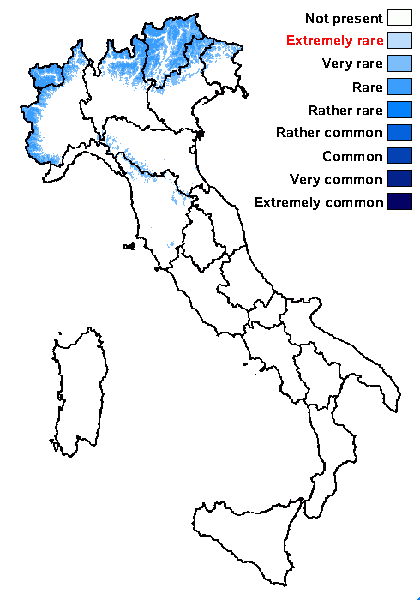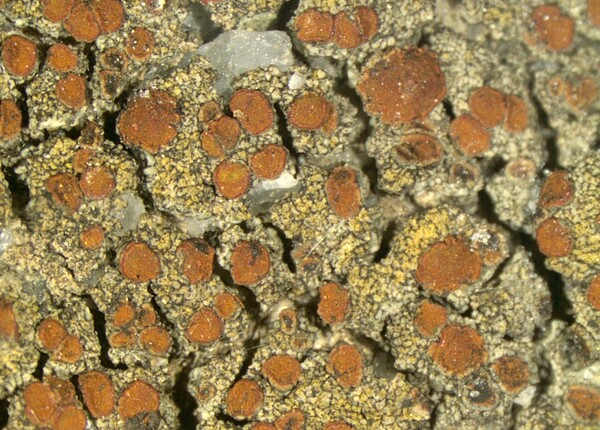Blastenia psychrophila Halıcı & Vondrák
in Vondrák & al., J. Syst. Evol. 58, 3: 320, 2019.
Synonyms: Caloplaca crenularia auct. ital. p.p.
Distribution: N - Frl (Nascimbene & al. 2021), Ven (Nascimbene & al. 2021), TAA (Vondrák & al. 2020), Lomb (Anzi 1860 as Placodium festivum), Piem (TSB 35247), VA (Piervittori & al. 2004 as C. crenularia), Emil (TSB 4463). C- Tosc (Vondrák & al. 2020).
Description: Thallus crustose, episubstratic, grey (exceptionally with a yellowish tinge), partly >100 μm thick, rarely with rough, isidia-like outgrowths. Apothecia biatorine/zeorine, rust-red, 0.7-1.1 mm across. Proper exciple prosoplectenchymatous, C+ purple; epithecium orange-brown, granular, K+ red, C-; hymenium colourless, not inspersed with oil droplets; paraphyses simple or sparingly branched and anastomosing, 1.5-3 μm thick in lower part, the apical cells usually wider; hypothecium colourless. Asci 8-spored, clavate, functionally unitunicate, apically thickened with a broad internal beak, the inner part of apex and external cap I+ blue, Teloschistes-type. Ascospores 2-celled, polarilocular, hyaline, ellipsoid (10-)13.5-19(-25) x 6-9 µm, the equatorial thickening (“septum”) c. 6 µm. Pycnidia red. Conidia bacilliform, rarely narrowly ellipsoid, 3-5 x 1-1.5 μm. Photobiont chlorococcoid. Spot tests: thallus K-, C-, KC-, P-; apothecia K+ red. Chemistry: non-chlorinated anthraquinones in apothecial disc, chlorinated anthraquinones in exciple; thallus without anthraquinones; Cinereorufa-green in thallus. For further details see Vondrák & al. (2020). Note: A recently-described species growing on base-rich siliceous rocks in the southern and central European mountains, mostly above or near treeline (Alps, Northern Apennines). Several earlier records of B. crenularia (see Nimis 1993, 2016) from alpine-subalpine situations probably refer to this species.
Growth form: Crustose
Substrata: rocks
Photobiont: green algae other than Trentepohlia
Reproductive strategy: mainly sexual
Commonnes-rarity: (info)
Alpine belt: rare
Subalpine belt: rare
Oromediterranean belt: very rare
Montane belt: very rare
Submediterranean belt: absent
Padanian area: absent
Humid submediterranean belt: absent
Humid mediterranean belt: absent
Dry mediterranean belt: absent

Predictive model
Herbarium samples
Growth form: Crustose
Substrata: rocks
Photobiont: green algae other than Trentepohlia
Reproductive strategy: mainly sexual
Commonnes-rarity: (info)
Alpine belt: rare
Subalpine belt: rare
Oromediterranean belt: very rare
Montane belt: very rare
Submediterranean belt: absent
Padanian area: absent
Humid submediterranean belt: absent
Humid mediterranean belt: absent
Dry mediterranean belt: absent

Predictive model
| Herbarium samples |
 INDEX FUNGORUM
INDEX FUNGORUM
 GBIF
GBIF
 DOLICHENS
DOLICHENS


